"Tricky Dick" and His Foreign Tricks
By Danny Do
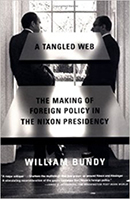
William P. Bundy
William P. Bundy was born September 24, 1917 and died on October 6, 2000. He was an attorney and an analyst for the CIA. He is notable for being the foreign affairs advisors for presidents John F. Kennedy and Lyndon B. Johnson. In 1969, he became a historian of foreign affairs and taught at MIT and Princeton University.
The 1970s was a period of vast change, evolution, and most importantly, foreign policy. Under Richard Nixon, foreign policy was vastly affected and focused on North and South Vietnam as well as the Soviet Union. He brought new ideas and thoughts to the political platform and possessed an outstanding administration. In A Tangled Web by William P. Bundy, he goes through the whole of the Vietnam War and explains several important dealings with the Soviet Union during the Cold War. Bundy reveals the history of foreign policy in the 1970s in entirety from an economic, political, and military point of view.
In William P. Bundy’s, A Tangled Web, the book begins with the election of 1968 among Republican favorite Richard Nixon, Democrat Herbert Humphrey, and American Independent George Wallace. Bundy describes Richard Nixon as the man of the hour, the man with the most important duty. Nixon had a deep impression on two fronts: political campaigning and extensive foreign policy experience. Nixon was greatly involved in communism within East Asia as he pushed for containment in the Southeastern countries. His foreign policy experience continued to grow with the Marshall Plan in the Middle East and showed hard work and critical thoughts on foreign policy. As Vice President, Nixon showed strong political influence and great marks that would leave lasting impressions in the minds of voters. Bundy then goes back to explain foreign policy and the situation with Indochina from Kennedy’s and Johnson’s administration. On the topic of foreign policy, many congressional leaders opposed military action and wanted to develop a diplomatic policy of “united action.”1 In the 1960s, U.S. involvement in Indochina was not an issue as well as China’s growing influence on Southern Asia. The main foreign issue was Cuba. Fidel Castro’s constraint over Cuba proved a menacing force for the Americans and played a critical role in the election of 1960 when John F. Kennedy won by the smallest margin. Bundy explains that the worsening situation in Vietnam “led the Kennedy Administration to draw back from the regime and set up covert links to dissident military groups”.2 Bundy points out Diem’s repressive actions in 1963 against the Buddhist opposition to the South Vietnam government. This completely changed Americans’ views on the South and Kennedy saw Diem “as not only repressive but no longer effective”.3 With Vietnam becoming unmanageable, Nixon offered advice and believed that the U.S. should only negotiate with other countries when the U.S. military force is strong enough to back it up. After Kennedy’s assassination, the nation was lost and looked towards Lyndon B. Johnson for guidance and leadership. During his term, the Tet Offensive changed American people’s view of the war and its place in the political campaigns. As tensions in both domestic and foreign affairs stirred, Richard Nixon pledged for new leadership to end the war and make peace in the Pacific. On November 5, Nixon won the presidential election and became the nation’s 37th president. Bundy then describes the careful process on selecting Nixon’s cabinet with the most important choice being Henry Kissinger as Secretary of State. Kissinger brought two main objectives for U.S. negotiations: to bring about a staged withdrawal of external forces and to create a max incentive for contending forces in South Vietnam to work out a political agreement. These objectives tried to solve the two dominant policy problems with the Vietnam War and relations with the Soviet Union.
Bundy now shifts to the beginnings of the Nixon administration and their actions towards the Vietnam War. On December of 1968, Henry Kissinger and his staff put together a set of questions about the state of war and what might be done. Bundy reveals two points of view upon the Vietnam War. General Creighton William Abrams believed that the South Vietnamese could eventually deal with insurgency by themselves. On the other hand, Nixon and Kissinger felt that Abram’s response showed differences in judgement and a dearth of suggestion about new approaches on old programs. However on March 15, Nixon approved a program called “Vietnamization.” This program would end U.S. involvement in the Vietnam War and train the South Vietnam forces in order to increase their combat role. It would also reduce the number the U.S. combat troops in Vietnam and eventually halt U.S. influence. By the end of 1970, Nixon began the withdrawal program for 150,000 men over a period of 12 months. However, this still left the controversial issue of North Vietnam. To Dean Acheson, he was skeptical of the effectiveness of negotiation with North Vietnam. This influenced Nixon to consider enlisting the Soviet Union for peace in Indochina. Bundy now transitions to the relations with the Soviet Union. Because of the Soviet Union’s vast influence and nuclear arsenal, Nixon took the position that all negotiations towards arms control should go alongside an easing of political problems in the Middle East. During Nixon’s first year as president, there was constant reference and negotiation over nuclear weapons in the Soviet Union. U.S. policy contained the primary objective of knocking out Soviet missile and aircraft bases in order to cripple the Soviet’s military power. With the developing technology, Bundy describes both nations as “grappling with a new technology that drastically changed old assumptions and ways of thinking”.4 As months passed on, Cambodia played a critical role in the Vietnam War.
There was a new effort to redefine war powers of the President and role of Congress. This greatly affected the Soviet relations through the early 1970s. The uncertain Soviet- American relationship in the Middle East developed from “close consultation to outright confrontation”.5 The most striking feature of the Soviet situation was the failure of leadership to produce a Five-Year Plan. The U.S. was so invested towards the Soviet’s military buildup that they ignored the Soviet’s economical deficit. The most important factor of the relations between the U.S. and the Soviet Union was S.A.L.T., or the Strategic Arms Limitation Treaty. These S.A.L.T. sessions in 1970 were defined to exclude any attempt of agreement on MIRV warheads and solely on offensive missiles and weapons. The Soviets had a twofold proposal for S.A.L.T. First, an early agreement was to be reacted on ABM limitations. Second, S.A.L.T. must be combined with agreement to cooperate in reducing the danger of “accidental war caused by provocation of a third country”.6v Both sides came to recognize that any agreements on totals of offensive missiles would have to be in the form of a freeze as of some stated date. The policy of U.S. government was to reduce military pressure in the region of East Asia and the Pacific as tensions between the Soviets and U.S. diminish. In 1971, détente between U.S. and Soviet Union took shape and realization. Nixon and Kissinger put “a strong stamp” on the nation’s foreign policy.7 The Soviet Union wanted a European Security and Cooperation Conference to give at least a color of legitimacy and international acceptance to its continued domination. Nixon still thought that the Soviet Union could exert strong influence on Hanoi to accept a compromise peace settlement. During the U.S.-Soviet summit, Kissinger felt that the S.A.L.T. treaty, number of ABM sites, and the inclusion of submarine-launched missiles were impossible to handle. Leonid Brezhnev showed unfamiliarity with the negotiation situations and agreed to submit proposals to Hanoi for a peace settlement. During the summer of May 1972, the North Vietnamese abandoned their position in Paris. The basic truth was that an overconfident leadership in Hanoi “had initiated a campaign for which the South Vietnamese and Americans were well prepared”.8 Henry Kissinger believed that once peace was established the U.S. would provide North Vietnam with massive economic aid and help with reconstruction. Since May of 1972, relations with Soviet Union had seemed leveled, and there was hope that substantial progress would be made toward a new arms control agreement on offensive missiles.
Towards the end of book, Bundy focuses on the Middle East War and the rise of Gerald Ford. The Middle East War was described as Anwar el-Sadat’s war with Israel and was dominated by expulsion of Soviet military presence. The expulsion freed Sadat’s hand and made improvements to Egyptian military posture. The two dominant themes in post-war Saudi Arabian policy were always fervent anti-Communism and anti-Zionism. In October 14, a massive Egyptian offense broke though Milta and Giddi passes on the Sinai Penisula “precipitated one of the largest tank battles in military history”.9 The movement on the oil front caused oil prices to rise 70%. Oil shortages and high energy prices were demoralizing to American vulnerability. After Nixon’s Watergate Scandal, Gerald Ford replaced him as the 38th president and had to deal with the Watergate legacy and the economic crisis. A new S.A.L.T. agreement, S.A.L.T. II, was put together in hopes of renewing U.S.-Soviet relations. Many Americans believed that the whole S.A.L.T. process was important in tamping down the arms race and getting two sides to understand each other. Richard Nixon brought to his presidency extraordinary abilities and experience while Gerald Ford brought straightforwardness and broad sense in the political scene. Henry Kissinger was the foremost advisor and actor in Nixon’s administration. There were two features that stood out from Nixon’s presidency: crisis management and neglect of professionals in the State Department.
The thesis of William P. Bundy’s, A Tangled Web, is that Richard Nixon exceeded his predecessors and brought an entirely new approach to foreign policy that was filled with patience, careful thought, and assertive action. With his administration and Henry Kissinger, they acted upon what they thought was necessary and most effective. When different views arose on U.S.’s position in South Vietnam, there was “strong antipathy and distrust that both Nixon and Kissinger felt toward career officers in the State Department, in part for what they supposed were liberal tendencies verging on disloyalty and in part, somewhat paradoxically, for alleged stodginess and resistance to change”.10 Nixon and Kissinger took control and ignored the expectations set by their predecessors. They felt that their State Department and Congress possessed the attitudes of the older traditions towards foreign policy. Instead, Nixon knew it was his responsibility to dissolve the tensions between Indochina and Soviet Union. Therefore, Nixon proved with his approach to the Vietnam War and the Soviet crisis that he could bring a new level of open mindedness and patience that the U.S. so needed in its foreign policy.
William P. Bundy was an attorney and intelligence expert. He was also a foreign affairs advisor to both President John F. Kennedy and President Lyndon B. Johnson. His work with these two presidents may have caused a bias in A Tangled Web. Richard Nixon and his administration brought a new perspective towards dealing with the Vietnam War and relations with the Soviet Union. This greatly differed from the previous administrations and may have angered or produced opposition from individuals such as William P. Bundy. In his work, he explains many of Nixon’s and Kissinger’s actions as always needing a more active role in the world. For example, as he writes about Nixon and Thieu’s negotiations, “in Nixon’s mind the conviction that negotiations were unlikely to produce an acceptable outcome until something more had been added”.11 Bundy also describes Nixon as a president who always needs assurance before he acts. While describing S.A.L.T. talks with Soviet Union, Bundy writes that Nixon suggested that negotiations would be ineffective unless the U.S. possessed a massive military force. Bundy’s historiography may have also played an important role in creating a bias in his work. A Tangled Web was written and published in 1998, the first year of George W. Bush’s presidency and the end of the Cold War. Since it was the end of the Cold War, Bundy may have taken the result and applied it to what could’ve happened if the Nixon Administration acted a different way towards Soviet relations. He would believe that a more affirmative and active role with reducing arms in the Soviet Union would ensure an end to the Cold War much sooner that late 1990s.
According to Evan Thomas and Garry Woodard, William P. Bundy’s book was written to deceive the reader on Richard Nixon and his administration’s actions. He portrays a sense of old conclusions rather than a new perspective and view on Nixon and his foreign policy. In Evan Thomas’s review he applauds Bundy for writing “clearly and gracefully and at times with narrative derive,” but criticizes him for his “diplomatic history than the average reader will know.”12 To Thomas, Bundy doesn’t offer as much personal insight and opinion to his work, but more a recollection of what transpired under Nixon’s presidency in foreign policy. Similarly, Garry Woodard describes A Tangled Web as “not…the final word.”13 Since the book’s publication there has been new information that has been uncovered involving China and the Soviet Union. Woodard also points out Bundy’s frequent reference to Kissinger and his role in Nixon’s administration. He reveals that there was a “tangled tale of Bundy’s themes: the ‘inner confidence that Kissinger and Nixon had in ultimate American power and control of its allies…”14 To Woodard, Nixon and Kissinger were the faces of foreign policy and that they controlled their “world of heroes and villains.”15 Both critics saw Bundy’s work as an accurate and well-written account of history, but felt it was simply just history rather than Bundy’s own personal opinions and thoughts.
Bundy’s A Tangled Web was a very effective and inspiring work that included all aspects of the foreign policy in the 1970s, a critical period for Nixon’s administration. It provided numerous accounts towards the events that transpired such as the Vietnam War, Soviet relations, and the Middle Eastern crisis. Many points of views were described for the readers so that they may not be drawn towards one bias or belief. For example, Bundy describes military arms negotiations with a “split that had emerged during 1968 between the military command in Vietnam (MACV) and the CIA.”16 The book showed great detail and depth within the Vietnam War with both domestic and international effect. It also provided critical events towards Soviet Union relations such as S.A.L.T. and peace talks. Overall, A Tangled Web has a strong foundation of historical evidence and accounts, but lacked the true opinion of the author and Bundy’s views on the U.S.’s response to foreign situations.
Bundy sees the 1970s as a time of transforming foreign policy within the U.S. He believes that with the extensive influence of the United States it provides a new outlook on foreign policy from the Nixon administration. Bundy sees the transition from presidencies during the 1968 towards the 1970s as a shift from old to new policies towards foreign countries. A continuation of Kennedy’s and Johnson’s policies are still present, but Nixon and Kissinger provide a more assertive and influential role with the Vietnam War and Soviet relations during the Cold War. Bundy describes Nixon’s “passionate belief in American commitment to Southeast Asia” as a shift from the 1960s and the new powers the government possesses to deal with international affairs.17
In the final analysis, William P. Bundy’s A Tangled Web uncovers the depth and detail of the Vietnam War as not merely an effort for containment and the Soviet Union relations as not merely peace talks. Each has their own meaning in how it affects U.S. domestic policy and changes the image of America as a peace-keeping nation. To Nixon, “each had a lesson for him that he would have done well to learn.”18
Footnotes:
1. Bundy, William. A Tangled Web. New York Hill & Wang, 1998. 33.
2. Bundy, William. 34.
3. Bundy, William. 176.
4. Bundy, William. 301.
5. Bundy, William. 306.
6. Bundy, William. 437.
7. Bundy, William. 636.
8. Bundy, William. 786.
9. Bundy, William. 109.
10. Bundy, William. 116.
11. Bundy, William. 115.
12. Thomas, Evan. “Practiced Deception.” The New York Times. The New York Times Company, 24 May 1998. Web. 31 May 2015.
13. Woodard, Gary. “To Conceive or Deceive?” Review of William Bundy, A Tangled Web—The Making of Foreign Policy in the Nixon Presidency. Hill & Wang, 23 Aug. 1999. Web. 31 May 2015.
14. Woodard, Gary. 1.
15. Woodard, Gary. 1.
16. Bundy, William. 115
17. Bundy, William. 916.
18. Bundy, William. 935.
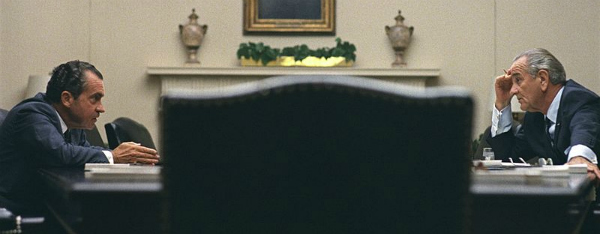
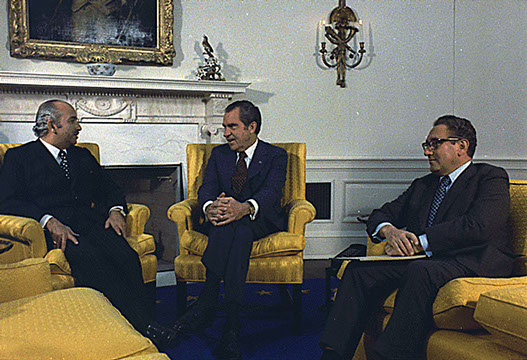
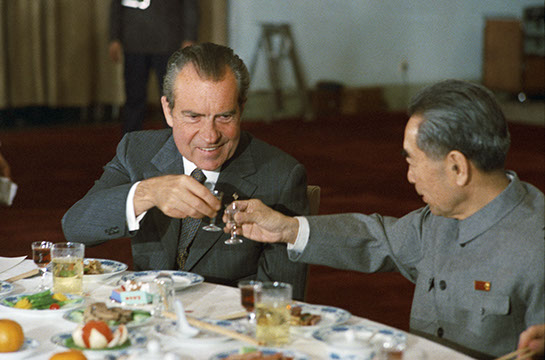
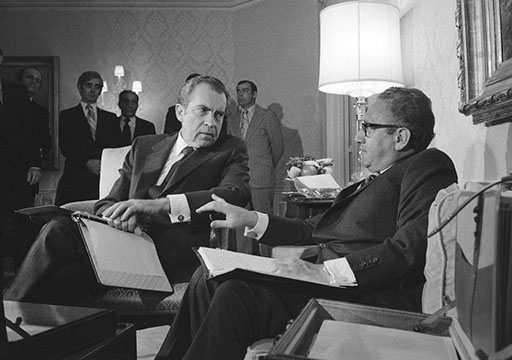
4 - 4
<
>